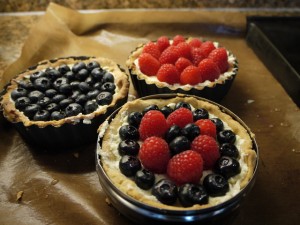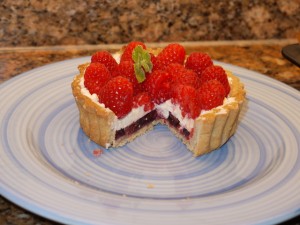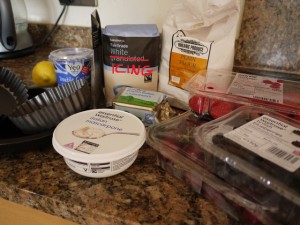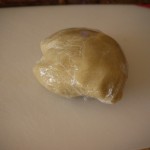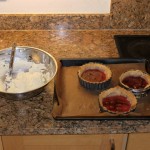Patisserie is the fine art of creating pastries, with most pastry chefs working a long apprenticeship and passing a written exam before they are entitled to use the title patissier. The idea is to take simple sweet ingredients, prepare and present them in an extremely precise and perfect way that’s as pleasing to the eyes as to the palette. As a home cook, I’m quite happy to compromise on presentation if it tastes ok, so whilst the method is sound, you’ll have to imagine the photos looking a bit better.
This recipe was inspired by a recent episode of the Great British Bake Off, as well as a great looking blueberry tart that a friend made the other weekend. You might wonder why there’s a difference in how many tarts it makes when you use smaller or large tart tins. When sketching out the quantities on the back of an envelope, I was aiming to make a bit over 300 centimeters squared of tart surface area. Remember your pi r squared?
Whilst this tart has several layers, each of those layers is very simple, it’s only time consuming to make because of the number of elements, most of the time is spent waiting for things to chill or bake, so it’s good for a relaxed summers afternoon when you can pop in and out of the kitchen.
Ingredients
This makes enough for 3 12cm small tarts or 1 big 20cm tart.
Sweet shortcrust pastry
175g plain flour
100g cold butter
30g icing sugar
3 to 4 tablespoons of ice cold water
Cherry Jelly
makes 300ml
200g cherries (half price or frozen cherries are good for this)
60g sugar
200ml water
3 sheets of gelatine (depends on the gelatine’s strength and how set you like things)
Mascarpone filling
150g mascarpone cheese
90g double cream
3 drops vanilla extract
1 tbsp icing sugar
Toppings
Generous handfuls of your favourite summer soft fruits, I’ve used a punnet of raspberries and half a punnet of blueberries.
Method
Pastry
The first order of business is making the pastry tart cases. I use an electric mixer because I can, but many people are happy to rub cold butter into flour by hand without it melting all over the place. The secret to a good pastry is to keep it as cold as you can and work it as little as possible.
Combine the butter and flour icing sugar, then gently work in the cold water until the pastry just starts to come together in a ball. I needed a bit less than 4 tablespoons when pulsing it in through my mixer’s feeder tube. Knead it by hand 3 or 4 times to make it into a smooth ball, then wrap it in clingfilm and put it in the fridge for 30 minutes to rest.

Rolled pastry for a single tart, I measured the tin’s base and depth to make sure the pastry was about right the size
Start preheating your oven to 180C
Cherry Jelly
Whilst the pastry is chilling at this point, you can work on the cherry jelly because it takes ages to cool down and saves time later on. Stone the cherries and cut into half, put them into pan with the sugar and water and bring to the boil. Soak the gelatine leaves in a saucer of cold water so they become soft. Let the cherries simmer for 10 minutes to reduce it a bit to intensify the flavours then take off the heat and mix in the gelatine so it dissolves. Pour into a jug and leave it to chill down to room temperature, or fridge temperature if you’ve got the time.
Back to the pastry again
Once the pastry cases are chilled, put some greaseproof paper and baking beans (or whatever you’ve got to hand) into each tart and blind bake for 15 minutes. Take out of the oven when the pastry has set, remove the paper and beans, then bake for another 10-15 minutes until it’s golden grown.Once they’ve cooled to room temperature, carefully pour in about 1cm of jelly into each tart, then put them back in the fridge until they’ve set. This could take 2 to 4 hours.
Cream filling
To make the cream filling, beat the icing sugar and vanilla into the mascarpone until it’s smooth, along with a tablespoon of the cream to help let it down a bit. In another, very clean, bowl, whip the cream until it’s holding its shape and roughly doubled in volume. Gently fold the whipped cream into the mascarpone mix and put in the fridge.Assembling the tarts
Once the jelly has set properly, it will need to take the weight of the cream and fruit, we can start to assemble the finished tarts.
Using a piping bag or a spoon, carefully put a 1 to 1.5cm layer of cream on top of the jelly and use a wet palette knife to smooth it off. Arrange the fruit on the top in a decorative pattern, pushing the fruit every so slightly into the cream to hold it in place. If everything’s gone to plan, there should be a little gap between the top of the pastry and the top of the cream so that the fruit stays put, but still sticks up nicely.
Put it in the fridge until it’s set and ready to serve.
